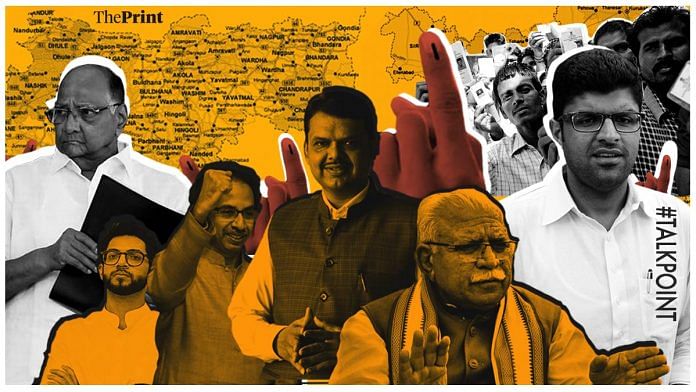The trends in the assembly election results in Haryana and Maharashtra show that the BJP and its allies might not register a sweeping victory. The Congress, NCP and JJP have shown surprising support among voters in the two states, even though they are still lagging behind the BJP and its allies.
ThePrint asks: Do Maharashtra and Haryana election results show that the opposition is not dead in India?
Congress talked of jobs, farmers’ distress, women’s safety. BJP raised Article 370 and NRC in Haryana
 Kumari Selja
Kumari Selja
President, Haryana Pradesh Congress Committee
It’s not just about the opposition being dead or alive, it is also about the will of the people. The BJP forgets at times that there’s a democracy in the country and that the will of the people always prevails.
While the Congress was discussing issues affecting the people of Haryana, the BJP was trying to constantly bring up Article 370 and the NRC. However, the people in Haryana rejected that politics, leaving the BJP squarely in the dark.
The Congress addressed issues such as unemployment, farmers’ distress, women’s safety, and also acknowledged concerns of the weaker sections of the society that failed to connect with the BJP. The SC/ST scholarship scam was a huge issue where all the money was siphoned off. Moreover, the BJP didn’t address issues of housing in Haryana and did not work to provide any ration cards for the poor.
After being in power for five years, the BJP should’ve gone to the people with a report card of all that they have done. But the party chose to deliberately divert people’s attention, knowing that it has failed the electorate. The people think that the BJP is not even willing to talk about issues that concern them.
Yet to be seen if Congress’s well-played hand or BJP’s shortcomings decided Haryana election outcome
 Swadesh Singh
Swadesh Singh
Assistant professor, Delhi University
Politics is always steeped in possibilities. One cannot write off even a fringe idea or force and its potential to challenge the dominant force. And, for a healthy democracy and its parliamentary system, a vibrant opposition inside and outside Parliament is essential.
That being said, the BJP of 1984 with just two MPs in Parliament was a better opposition than the Congress of 2019 with 52 MPs because the former continued to work outside the boundaries of Parliament. Between the opposition MPs flagging issues in Parliament and intellectuals writing letters to PM Modi — there are a lot of shades in the opposition.
Civil society organisations occupy this space of non-electoral opposition. The catch here is that this non-electoral space can also be easily tapped for electoral gains.
In Haryana, we will need to ascertain whether it was BJP’s inability to tap into the non-electoral forces or Congress’s well-played hand that decided the election outcome. The results so far show that opposition has emerged as a formidable force in the state, although it needs to take up the right issue at the right time.
Also read: 5 lessons BJP must learn from Maharashtra & Haryana election results
Maharashtra’s BJP govt didn’t focus on rural issues and this clearly angered people
 Abhay Deshpande
Abhay Deshpande
Political commentator
In the 2014 Lok Sabha elections, the BJP and the Shiv Sena were ahead in 227 assembly segments, after which around 21 MLAs from Congress defected to them. The BJP-Sena alliance is getting fewer seats than anticipated.
On the other hand, Congress and the NCP have managed to get more seats than expected. While the BJP-Shiv Sena alliance is doing well in Mumbai and other cities, they have faced a major setback in rural areas that were affected by floods. As of now, the trends are showing that Congress and NCP leading in well beyond 90 constituencies, outnumbering their 2014 tally.
And, despite their politics of defection, the BJP-Shiv Sena alliance is unable to get a majority. People have voted against this kind of politics. In 2014, the two parties had fought independently, where the Shiv Sena got 63 seats and BJP got 122. However, this time, the alliance is barely reaching 167, according to the latest estimates.
The reason for this can be attributed to the wave of anti-incumbency in Maharashtra. In the backdrop of the Balakot airstrikes, Pulwama terror attack, scrapping of Article 370, and the Ram Mandir issue, the BJP government didn’t pay enough attention to rural issues in the state. This clearly angered people.
Congress leader Rahul Gandhi only addressed six public rallies, while it was NCP chief Sharad Pawar who did the heavy lifting.
Retaining power but with an unimpressive voteshare this time signals a political setback for the BJP-Shiv Sena alliance in Maharashtra.
Return of dominant castes — Jats and Marathas — good news for Congress and its allies
 Rasheed Kidwai
Rasheed Kidwai
ORF visiting fellow and author of Sonia, a Biography and 24 Akbar Road
The so-called corpse is alive and kicking. The outcomes of Maharashtra and Haryana assembly polls are set to indicate that voters will give a wake-up call to the ruling party and coalitions regardless of the level of the opposition’s strength or weakness.
Haryana offers a compelling account of this where various social and political groups came together to give a rude shock to the BJP. Sonia Gandhi and Rahul Gandhi need to place faith in regional satraps like the Hoodas of Haryana, who have delivered in spite of getting treated shabbily.
The return of the dominant castes demanding reservations, the Jats in Haryana and Marathas in Maharashtra, is good news for the Congress-NCP alliance because its spillover effect will continue for time to come.
Propaganda or a curated narrative has its limitations and the potential to boomerang. The BJP carefully worked out a campaign of cultural and muscular nationalism even during assembly elections. Raking up the rationale behind diluting Article 370 that gave special status to Kashmir, the Balakot airstrikes, was so effective that it even misled various opinion poll and exit poll agencies. The pollsters failed to take into account how ruling parties neglecting pressing issues of bread and butter, jobs and the agrarian distress can affect the vote shares of parties accordingly.
When it comes to state elections, regional issues dominate
 Pradeep Bhandari
Pradeep Bhandari
Psephologist
To think that there is a situation where a permanent vacuum will exist in the place of the opposition is a utopian idea.
The tentative assembly election results in Haryana and Maharashtra suggest three things: first, people on the ground are signalling that the economy is not doing well; second, the BJP struggles in state elections because these do not involve seeking a Modi mandate; and third, the result of these elections will have a catalyst effect in upcoming assembly elections in Delhi, Jharkhand, and Bihar. These states will be examples of well-fought elections by all contesting parties. So, the talk of a no-opposition zone no longer holds water.
A number of leaders from the NCP and the Congress have defected to the BJP in recent months and the voters do not seem too happy with that. Sometimes, disappointed voters themselves create room for the opposition to revive itself.
When it comes to state elections, regional issues dominate. The voters understand very clearly when Modi needs to be given the mandate or when state-level political leaders, based on regional issues.
The BJP has, in fact, become weaker after aligning with the Shiv Sena, while struggling to form a government in Haryana against an aged Hooda of the Congress.
Also read: ‘Maratha warrior’ Sharad Pawar shows why he still matters in Maharashtra politics
By Taran Deol, journalist at ThePrint




It is not fair. BJP had mouthful of curses that has nothing else to do with election. PM led the parade with Doob Maro!!!.
Mainstream electronic media has become irrelevant. Nobody trusts them, their exit polls are atrociously unreliable. These channels are owned by the big business houses and reflect perverted senses of loyalty to those in power. We now have turn selectively to you tube channels who to some extent are providing with reliable feedback and balanced viewpoints .
Hamare liye toh Cut the Clutter hi kafi hai.
The opposition has relinquished its dependence on the bought-and-sold mainstream media in India. They now go directly to the people. Hence the improved performance. Opposition parties will do well to cultivate local media rather than national.
That one cannot judge, but the voters are certainly not brain dead.
people who are not brain dead are not certified as dead but one can be an alive desi voter in India voting for candidate with a fake degree.